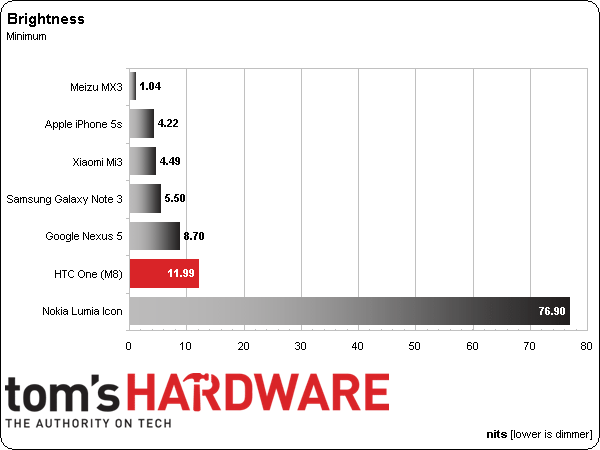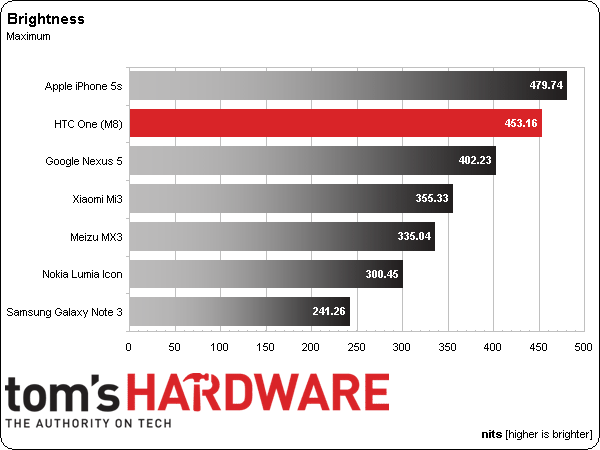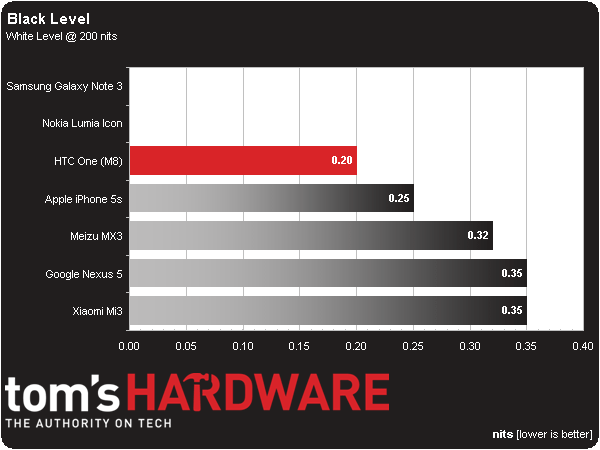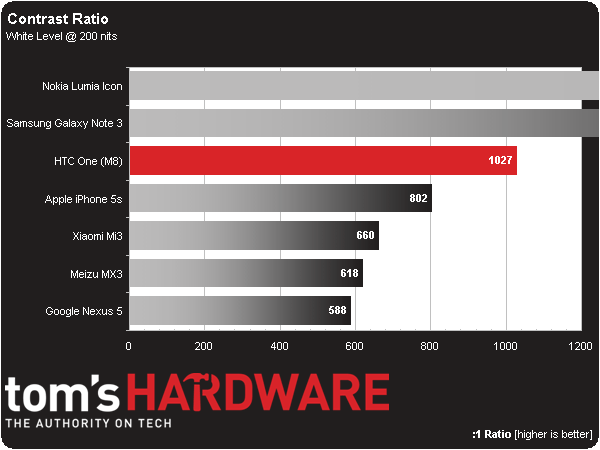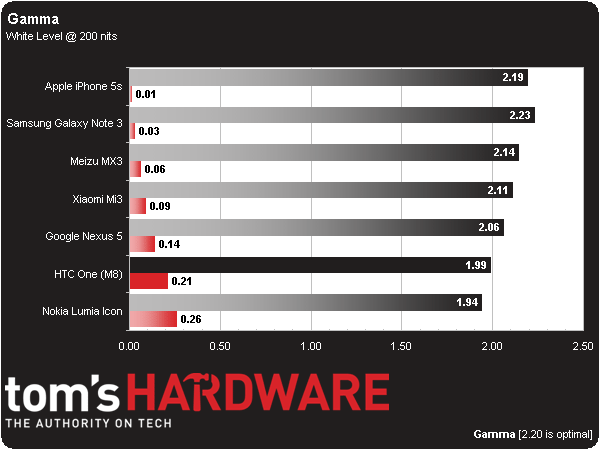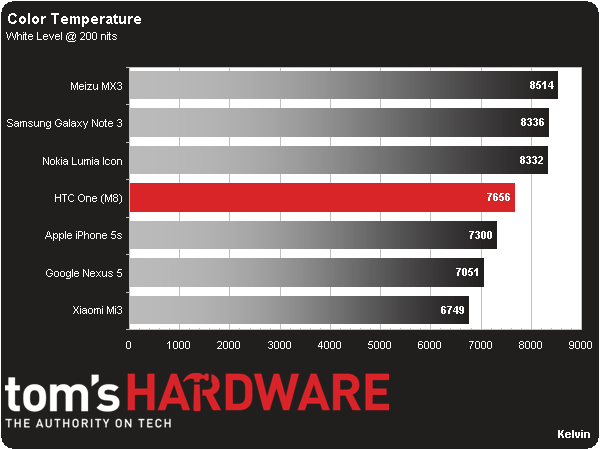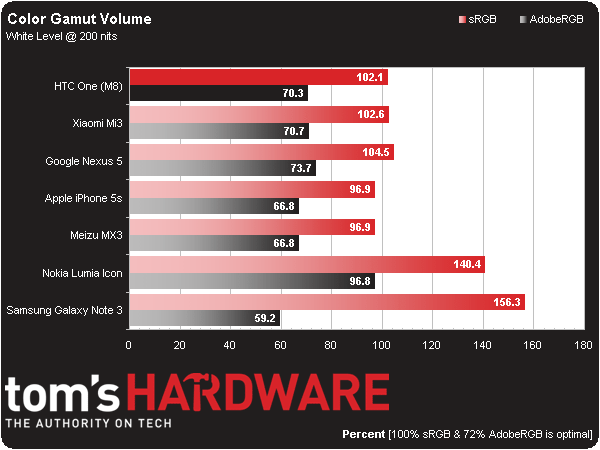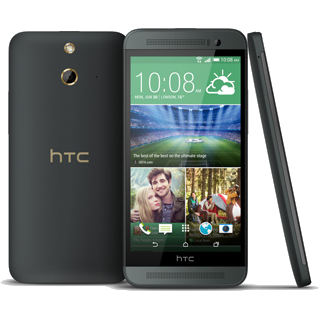HTC One (M8) And One (E8) Review: A Flagship And Its Sidekick
We run HTC's flagship Android smartphone, the One (M8), through our exhaustive benchmark suite. In addition, we take a close look at its less expensive sibling, the HTC One (E8). Both devices are compared and tested against a strong field of competition.
Brightness, Black Level, Contrast Ratio, And Gamma
Brightness
Brightness (also known as white level) measurements are taken by recording the luminance output of each device displaying a full white pattern, with the device's brightness slider set to both minimum and maximum values.
HTC's One (M8) has a high minimum brightness level, though it looks downright fantastic next to the Lumia Icon's three-stage brightness selection range. Separately, I've heard that an upcoming update to Windows Phone will address this with more configurable controls. In any case, the One (M8)'s maximum brightness level is second only to Apple's iPhone.
In order to make device comparisons possible, the rest of our display measurements (along with our battery testing) are performed with the screen set to a standardized 200 nits.
Black Level
Our black level measurement reflects the reading of a full black pattern after dialing in our 200-nit brightness. AMOLED displays always register zero, since their pixels simply turn off to render black. That's why the Galaxy Note 3 and Lumia Icon don't appear on our chart.
Traditionally, Samsung's AMOLED-equipped devices dominate, since AMOLED displays offer the best black levels. HTC's One (M8) delivers the best non-AMOLED result, though.
Contrast Ratio
Contrast ratio is the difference between a full white and full black patterns. Due to their zero reading on the black level tests, AMOLED displays are said to have an infinite contrast ratio.
The outcome isn't surprising, then. But HTC's One (M8) does perform excellently, demonstrating one of the best black level/contrast ratios we've seen from an IPS-based screen.
Get Tom's Hardware's best news and in-depth reviews, straight to your inbox.
Gamma
A gamma curve of 2.2 is what we're looking for. The reason for this is that images captured in the sRGB color space are encoded in a gamma of about 1/2.2. A gamma curve of 2.2 allows the resulting images to be viewed at the ideal brightness and contrast.
The One (M8) falls shy of an ideal gamma reading, which could be surprising after seeing how much attention went into the exceptional black level and contrast.
Color Temperature
Color temperature is a measurement in Kelvin, which is used to describe how “warm” or “cool” a given display is. Ideally, as long as you're not viewing your device in direct sunlight, this should be in the 6500 range. Higher color temperatures result in a cool, bluish hue, while lower temperatures deliver a warm or reddish tone.
HTC's One (M8) appears in the middle of the pack. It's cooler than we'd like, but only one position away from Apple's lauded iPhone 5s, too.
Color Gamut
Our volume measurements are compared against both the sRGB and AdobeRGB color gamuts. A reading of 100 percent on sRGB and 72 percent on AdobeRGB is the optimal reading for viewing the vast majority of digital consumer content. A lower reading is typically accompanied by an overly red or yellow image, and a higher reading is usually too blue/green.
HTC's One (M8) does well in this metric, approaching the gamut volumes we'd like to see.
Current page: Brightness, Black Level, Contrast Ratio, And Gamma
Prev Page Results: Web Benchmarks Next Page Results: Battery LifeDon Woligroski was a former senior hardware editor for Tom's Hardware. He has covered a wide range of PC hardware topics, including CPUs, GPUs, system building, and emerging technologies.
-
Heironious The pricing says 1,309.00 for it on Amazon? May as well buy it straight from an authorized dealer for half that. It's a gorgeous phone and I don't regret picking it up over the Samsung S5 (mostly because of the cheap plastic of Samsung).Reply -
LordConrad I love my M8 except for that stupid depth-camera, they should remove it and bring back OIS.Reply -
JOSHSKORN Just stop comparing to the iPhone 5s until a comparable 64-bit chip is released and implemented into Android phones. Until then, the iPhone 5s "appears to be faster" (only on benchmarks) but as many of us know, it justifies buying an iPhone for most users, even though a 64-bit processor in a mobile phone may be pointless (for now).Reply -
CaedenV If I were the android type I would get this phone hands-down. If they released a WP version then I would jump all over it over the stuff Nokia has been pushing out in 2014 so far.Reply
The only 'complaints' that I have are the lack of wireless charging (impossible due to the metal back plate right?), and the lack of a sort of Nokia Glance screen (though other android devices are picking up similar features). The cover seems to bring that Glance functionality... but I really don't like that cover and would rather not. The thing is that with my lowly 920 I have built myself an upright wireless charging stand, and with glance screen enabled whenever the device has access to power, it makes a most excellent clock/notification center. With my 920 approaching 2 years old I am starting to look for a replacement, and as of the moment I am not finding one. WP has seemingly abandoned the high end devices, I am not apple compatible, and Android devices have a lot of really neat features... but then you deal with non-standard UIs and gimmickey software. I really hope something really good comes out before Christmas because the 920 is not getting any younger. -
stevessvt Wow, these benchmarks are, by far, the lowest I have seen for the M8. 27K in Antutu? Was power saver on?Reply -
Avus Holy!! $1300 for a phone.... I am too cheap for that...Reply
I am currently using Nexus 5 and happy with it. If I want to buy a phone now, I may want to get an Oneplus One. -
envy14tpe Great phone but that camera is what holds me back from buying it. So Samsung or Google gets my money, although Apple has the best camera. (However, no Apple..screen wayyy to small...Android flagship phones have been over 4" for 2+ years)Reply -
TeKEffect Me and my friend are both having problems with the usb port. They went cheap on the cheapest part. I would google the problem before getting the one.Reply
